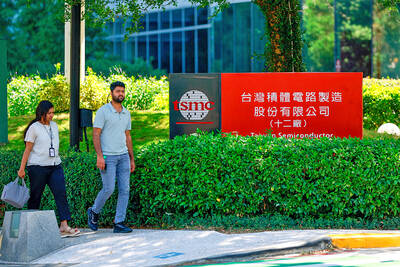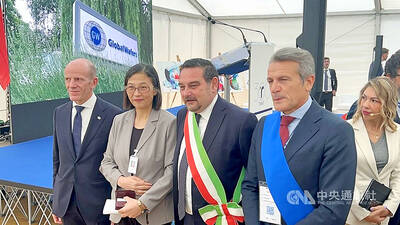There is a huge potential for further economic cooperation between Taiwan and India, after its new government led by Indian Prime Minister Narendra Modi announced its intentions to attract foreign investment to revamp the nation’s slumping economy, Yuanta Investment Consulting Co (元大投顧) said last week.
In addition, an economic cooperation agreement (ECA) similar to a free-trade agreement with India, which is intended to lower or remove bilateral tariffs and other trade barriers, would be a strong incentive for Taiwanese exporters and investors to tap into the South Asian country’s market, Yuanta said in a research report issued on Friday.
The report came after the Bureau of Foreign Trade said earlier in the week that Taiwan is to send an economic and trade delegation to India in September to encourage two-way investment, and Taipei is to host a Taiwan-India investment forum in October.
In a statement posted on its Web site on Thursday, the bureau said it signed a renewed memorandum of understanding with Standard Chartered PLC on June 11, as Taiwan plans to continue relying on the UK lender’s regional resources to help foster its bilateral trade with India.
India ranks 20th among Taiwan’s trading partners, the bureau said.
Modi’s Bharatiya Janata Party won a historic election victory last month largely because of his promise to boost economic growth in India, with a plan to shape the nation into a global manufacturing hub.
As a result, Modi and his government are expected to speed up the review process for major commercial projects, encourage private investment in the coal and defense sectors, establish industrial zones and provide incentives to accelerate the development of labor-intensive manufacturing in Asia’s third-largest economy, Yuanta researcher Wendy Kuo (郭香妏) said.
However, the implementation of policies will be the key to investment and consumption growth, she said.
Bilateral trade between Taiwan and India totaled US$6.17 billion last year, growing by more than 400 percent from US$1.2 billion in 2000 and represented an increase of 556 percent from US$940 million in 1995, when the two countries first set up representative offices to deal with trade and cultural exchanges, the bureau’s statistics showed.
However, the nation’s foreign direct investment (FDI) in India remains relatively minor, ranking the 41st-largest as of the first quarter of last year, according to tallies compiled by the Department of Commerce in India.
Between 2000 and March last year, Taiwan invested US$65.7 million in India, accounting for 0.03 percent of India’s total foreign investment during the period, statistics showed.
Since Taiwan has been seeking trade ties in South Asia in recent years, India is likely to be a close economic and investment partner, Kuo said.
“India and Taiwan have agreed to form a task force to facilitate the Taiwan-India economic cooperation agreement,” she said, adding that the upcoming investment forum in October would mark the first step toward signing the ECA.
Kuo said the industries that Taiwanese companies have invested in India have been similar to those invested in within China.
“As the China market is stabilizing or even facing saturation, we believe Taiwanese companies will expand globally, with India a starting point given its huge market and low labor costs,” she said.
Taiwanese investment in India is mainly focused on information and communications technology, machinery, transportation, engineering, metal manufacturing and shoemaking, as well as the agriculture and fishery sectors.
Based on Yuanta’s research, the manufacturing segment currently accounts for just 15 percent of India’s GDP, lower than China’s 30 percent, because of the country’s lagging infrastructure development, slow-moving bureaucratic system and high interest rates that hinder business investment.
India’s economy grew 4.6 percent in the first quarter of the year from a year earlier.
Yuanta forecast India’s GDP would grow by about 5.5 percent this year and 6.5 percent next year.

RECYCLE: Taiwan would aid manufacturers in refining rare earths from discarded appliances, which would fit the nation’s circular economy goals, minister Kung said Taiwan would work with the US and Japan on a proposed cooperation initiative in response to Beijing’s newly announced rare earth export curbs, Minister of Economic Affairs Kung Ming-hsin (龔明鑫) said yesterday. China last week announced new restrictions requiring companies to obtain export licenses if their products contain more than 0.1 percent of Chinese-origin rare earths by value. US Secretary of the Treasury Scott Bessent on Wednesday responded by saying that Beijing was “unreliable” in its rare earths exports, adding that the US would “neither be commanded, nor controlled” by China, several media outlets reported. Japanese Minister of Finance Katsunobu Kato yesterday also

Jensen Huang (黃仁勳), founder and CEO of US-based artificial intelligence chip designer Nvidia Corp and Taiwan Semiconductor Manufacturing Co (TSMC, 台積電) on Friday celebrated the first Nvidia Blackwell wafer produced on US soil. Huang visited TSMC’s advanced wafer fab in the US state of Arizona and joined the Taiwanese chipmaker’s executives to witness the efforts to “build the infrastructure that powers the world’s AI factories, right here in America,” Nvidia said in a statement. At the event, Huang joined Y.L. Wang (王英郎), vice president of operations at TSMC, in signing their names on the Blackwell wafer to

‘DRAMATIC AND POSITIVE’: AI growth would be better than it previously forecast and would stay robust even if the Chinese market became inaccessible for customers, it said Taiwan Semiconductor Manufacturing Co (TSMC, 台積電) yesterday raised its full-year revenue growth outlook after posting record profit for last quarter, despite growing market concern about an artificial intelligence (AI) bubble. The company said it expects revenue to expand about 35 percent year-on-year, driven mainly by faster-than-expected demand for leading-edge chips for AI applications. The world’s biggest contract chipmaker in July projected that revenue this year would expand about 30 percent in US dollar terms. The company also slightly hiked its capital expenditure for this year to US$40 billion to US$42 billion, compared with US$38 billion to US$42 billion it set previously. “AI demand actually

Taiwan-based GlobalWafers Co., the world’s third largest silicon wafer supplier, on Wednesday opened a 12-inch silicon wafer plant in Novara, northern Italy - the country’s most advanced silicon wafer facility to date. The new plant, coded “Fab300,” was launched by GlobalWafers’ Italian subsidiary MEMC Electronics Materials S.p.A at a ceremony attended by Taiwan’s representative to Italy Vincent Tsai (蔡允中), MEMC President Marco Sciamanna and Novara Mayor Alessandro Canelli. GlobalWafers Chairwoman Doris Hsu (徐秀蘭) said the investment marked a milestone in the company’s expansion in Europe, adding that the Novara plant will be powered entirely by renewable energy - a reflection of its